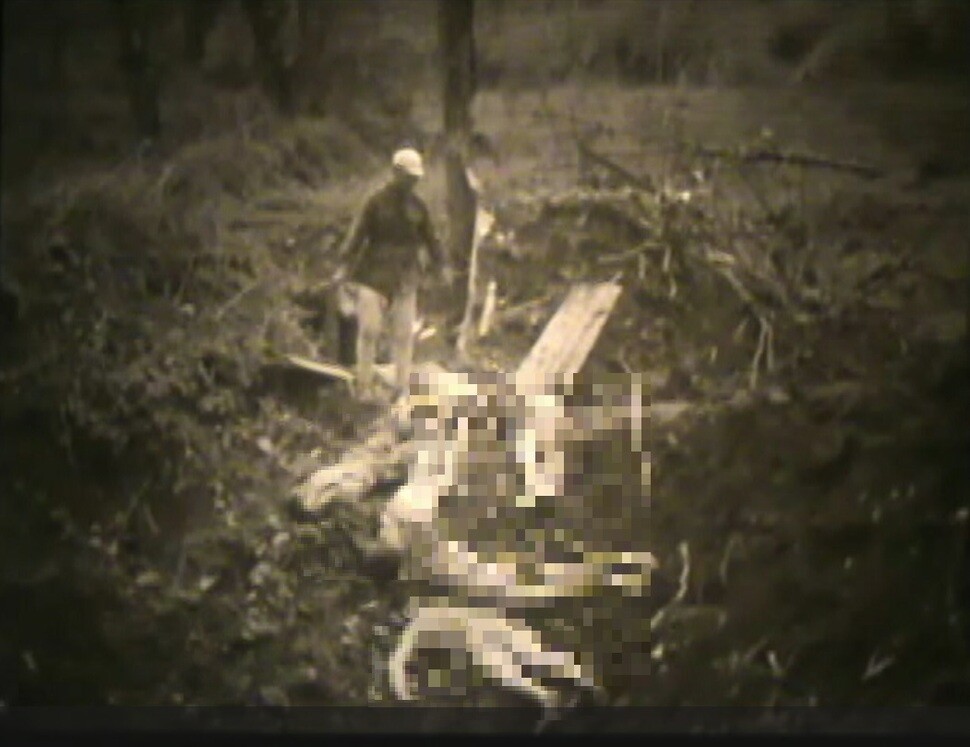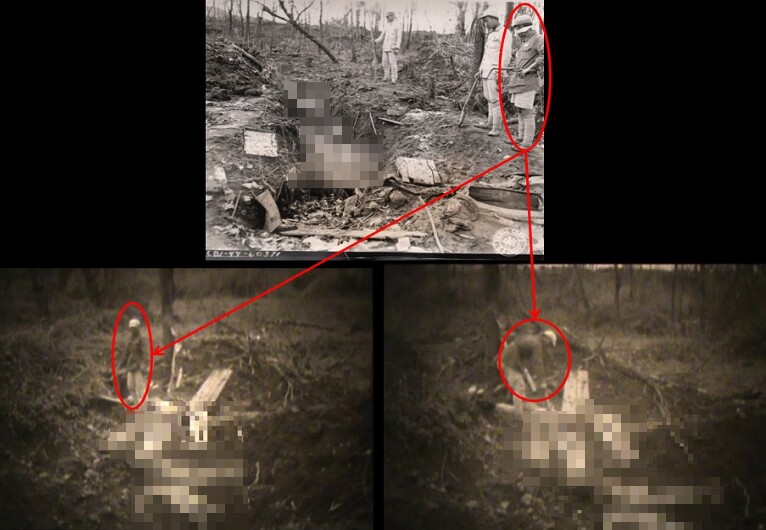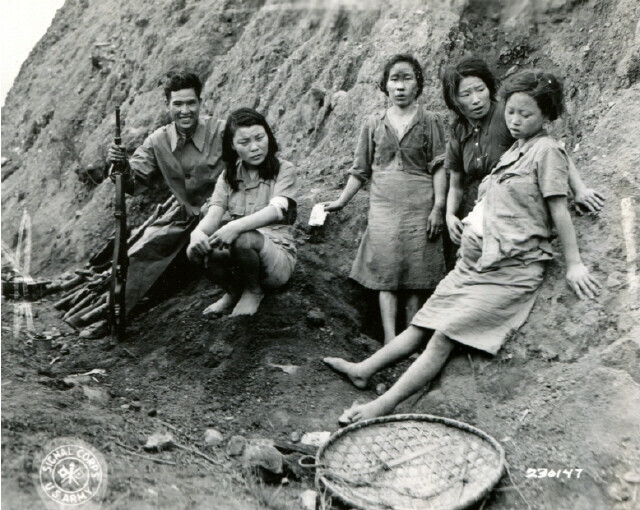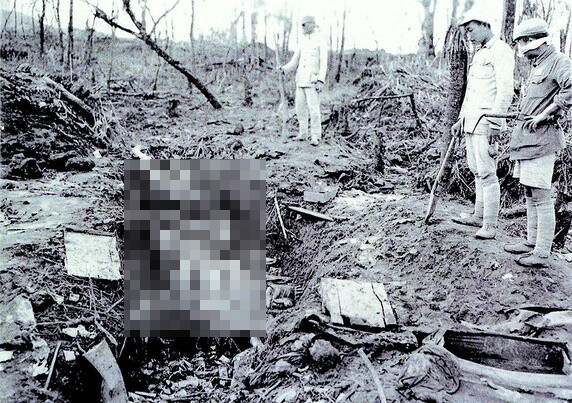hankyoreh
Links to other country sites 다른 나라 사이트 링크
Video evidence surfaces showing Korean comfort women were massacred by Japanese military

Documents and video footage have been found showing massacres of Korean comfort women by the Japanese military shortly before the end of World War II. During the South Korea-China-Japan Comfort Women International Conference held at Seoul City Hall on Feb. 27, the city of Seoul and the Seoul National University (SNU) Human Rights Center made public for the first time footage of the aftermath of a massacre of Korean comfort women. The footage was released after a team of researchers led by Jung Jin-seong on behalf of the Seoul city government and the SNU Human Rights Center uncovered and studied materials during the course of two visits to the US National Archives and Records Administration in 2016 and 2017.

Articles appearing at the time reported that Japanese troops had massacred comfort women, such as one that appeared in the Sept. 18, 1944, edition of the Shaodangbao, the official gazette of China’s Nationalist Party, known as the Kuomintang, but this is the first time that footage has been made public. This footage flatly contradicts the Japanese government’s denial of the forced mobilization and massacre of the comfort women.
The footage shows a Chinese soldier, apparently on a burial detail, looking at naked corpses and then removing the socks off one of them. Smoke is rising from one corner of the frame.

“It’s blurred out in the version for public release, but the original footage shows corpses missing heads and other body parts, allowing us to infer the cruelty of the events in question,” the research team said.
This footage, which is reminiscent of the slaughter of Jews in Nazi Germany, was taken by a soldier named Baldwin from a photography company with the allied 164th Signal Corps in the city of Tengchong, in China’s Yunnan Province, on Sept. 15, 1944. Seven seconds in the middle of the 19-second film clip show the entrance to the Tengchong castle, while six seconds at the beginning and at the end show the inside of the castle. Drawing upon allied reports that were released along with the footage, the Seoul city government and the SNU Human Rights Center concluded that the footage shows “the scene of a mass shooting of Korean comfort women who had been forcibly mobilized by the Japanese imperial army.”
During the Salween Campaign launched by combined US and Chinese forces in May 1944 to cut the Japanese army’s lines of communication in southwestern China, cities under the control of the Japanese, including Songshan, Tengchong and Longling, fell to the allies one after another. In Sept. 1944, as it became obvious that Japan would be defeated in the war, Japan’s chief of operations Colonel Masanobu Tsuji ordered Japanese troops garrisoned in Songshan and Tengchong to “keep resisting until reinforcements arrive in October.”
Comfort women who refused suicide were shot by Japanese soldiersHistorians interpret this as basically being an order for compulsory mass suicide. There were between 70 and 80 Korean comfort women in Songshan and Tengchong, and it is presumed that most of the comfort women who refused to kill themselves were shot by the Japanese soldiers.
“On the evening of Sept. 13, Japanese troops slaughtered 30 Korean women who were in [Tengchong] Castle,” says a report filed at 6:55 pm on Sept. 14 by the US-Chinese Allied 54th Army. The report was found in government records. In 2017, the research team released a photo showing seven women who escaped from Songshan after being forced to become comfort women for the Japanese army. Lists of names and POW records from the time suggest that 23 of the comfort women at Songshan and Tengchong escaped and that 30 were massacred. There were also many other deaths that cannot be confirmed.
A photo showing the corpses of Korean women massacred in China was published in 1997. Since this photo was not accompanied by a clear explanation or related documents, there was a debate about whether it should be treated as evidence of a comfort women massacre. Focusing on the fact that videographers and photographers worked together during the war, the research team managed to locate footage that may have been shot at the same time as the photo in question.

A Chinese soldier wearing the same attire appears in both the previously released photo and the newly released footage. Based on the camera angle and the condition of the bodies, both the footage and the photo were shot at the same location.
“All of the reports about wartime conditions that appear in the documents are written in the passive voice except for the record from Sept. 14, 1944, which says that Japanese troops did the shooting. That’s the only sentence that identifies the responsible party. By cross-referencing the new documents and footage with the older photograph, we were able to provide objective evidence of a comfort women massacre,” said Kang Sung-hyun, a professor at Sungkonghoe University who was involved in the research.
The footage of the aftermath of the massacre stands as clear evidence of how the Japanese troops treated the comfort women. According to several military documents, the Japanese troops regarded the comfort women not as people but as their own “exclusive supplies” and forced the comfort women to accompany them and serve as their sexual tools until it came time to dispose of them.
Calls for Japanese government to acknowledge instances of human rights abuses“Under the regime of Prime Minister Shinzo Abe, Japan has disregarded even the testimony of the surviving comfort women, claiming that this is not clear evidence. Now that this material has been made public, Japan needs to face up to these extreme instances of human rights violations that were perpetrated during the wartime mobilization. I hope that this example will reverse Japan’s recent shift toward historical and evidentiary revisionism,” Kang said.
Hisatomo Kobayashi, an activist with the National Campaign for Solving the Problem of the Comfort Women for the Japanese Military and a participant in the conference, called on the Japanese government to change its attitude. “The Japanese government is still denying responsibility on the grounds that there are no records that obviously and directly show the forcible mobilization of the comfort women. But the truth continues to be revealed through documents about the comfort women. Last year, the National Archives of Japan submitted 182 documentary records to the Japanese Cabinet showing that the Japanese military directly mobilized comfort women and forced them to become sex slaves on the island of Bali,” he said.
During the conference, which was attended by comfort women experts from South Korea, China and Japan, Park Jeong-ae, a researcher at Dongguk University, shared the concerns she had felt before the release of gruesome photos and video footage recorded from the perspective of male soldiers.
“Since there is already abundant material to demonstrate the culpability of the Japanese government, it’s time for us to discuss ways to protect personal information and the human rights of the comfort women before releasing material,” Park suggested.
By Nam Eun-ju, staff reporter
Please direct questions or comments to [english@hani.co.kr]

Editorial・opinion
![[Column] Season 2 of special prosecutor probe may be coming to Korea soon [Column] Season 2 of special prosecutor probe may be coming to Korea soon](https://flexible.img.hani.co.kr/flexible/normal/500/300/imgdb/original/2024/0426/3317141030699447.jpg) [Column] Season 2 of special prosecutor probe may be coming to Korea soon
[Column] Season 2 of special prosecutor probe may be coming to Korea soon![[Column] Park Geun-hye déjà vu in Yoon Suk-yeol [Column] Park Geun-hye déjà vu in Yoon Suk-yeol](https://flexible.img.hani.co.kr/flexible/normal/500/300/imgdb/original/2024/0424/651713945113788.jpg) [Column] Park Geun-hye déjà vu in Yoon Suk-yeol
[Column] Park Geun-hye déjà vu in Yoon Suk-yeol- [Editorial] New weight of N. Korea’s nuclear threats makes dialogue all the more urgent
- [Guest essay] The real reason Korea’s new right wants to dub Rhee a founding father
- [Column] ‘Choson’: Is it time we start referring to N. Korea in its own terms?
- [Editorial] Japan’s rewriting of history with Korea has gone too far
- [Column] The president’s questionable capacity for dialogue
- [Column] Are chaebol firms just pizza pies for families to divvy up as they please?
- [Column] Has Korea, too, crossed the Rubicon on China?
- [Correspondent’s column] In Japan’s alliance with US, echoes of its past alliances with UK
Most viewed articles
- 1[Column] Season 2 of special prosecutor probe may be coming to Korea soon
- 2‘We must say no’: Seoul defense chief on Korean, USFK involvement in hypothetical Taiwan crisis
- 3Is N. Korea threatening to test nukes in response to possible new US-led sanctions body?
- 4No good, very bad game for Korea puts it out of Olympics for first time since 1988
- 5Is Japan about to snatch control of Line messenger from Korea’s Naver?
- 6Division commander ordered troops to enter raging flood waters before Marine died, survivor says
- 7Korea’s 1.3% growth in Q1 signals ‘textbook’ return to growth, says government
- 8N. Korean delegation’s trip to Iran shows how Pyongyang is leveraging ties with Moscow
- 9[Editorial] Korea’s surprise Q1 growth requires objective assessment, not blind fanfare
- 10[Editorial] Government needs to stop impeding Sewol mourning